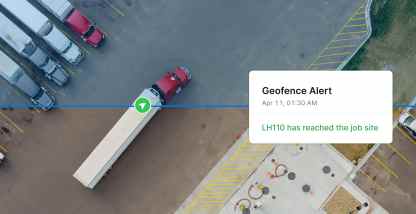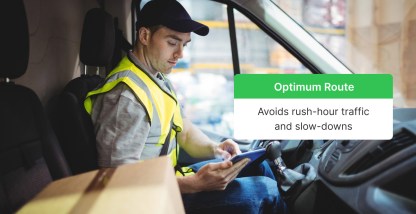When it comes to fleet management, delivery route planning is one of the most essential parts of your job. But it’s also what tends to make the most time.
If you manage a fleet of vehicles, you’ll more than likely need to plan dozens of delivery routes per vehicle every day. With large fleets, this can often involve planning hundreds, if not thousands, of routes for drivers to take. Anything more than a couple of vehicles and this becomes virtually impossible. That is, of course, unless you have the right tools.
What is route optimization?
Whether you’re the manager or operational advisor of a fleet or a driver within a fleet, knowing which are the best routes to take to get you to your destination as quickly and smoothly as possible is likely often at the forefront of your mind. This is where robust route optimization software can help.
Route optimization involves finding the most time- and cost-efficient routes to take when driving between stops. As a business that manages fleets for deliveries, optimizing your route helps maximize your time and the number of orders you complete in one journey.
At its core, route optimization helps your drivers find the shortest routes to reduce time spent on the road. However, the best types of software also consider other variables to maximize efficiency:
- Customer time windows: If a customer has inputted a specific window of time they’re available to accept the delivery, the route optimization software will amend the driver’s available routes to better ensure they can make the delivery within that time.
- Vehicle capacity: By inputting the number of packages transported in the vehicle at once according to weight and volume capacity into the software, it can easily calculate exactly how many orders can be delivered while on route to determine the number of stops required. This also helps optimize safe driving, as the software can help understand the weight of each package and show when a vehicle is overcapacity.
- Traffic congestion: GPS with route optimization will update the road conditions in real time to notify drivers of any known traffic congestion, accidents, or road closures. By sending these notifications, drivers can choose from the recommended alternative route to avoid wasting time in stand-still traffic.
- Distance between stops: Drivers are given an exact view of the distance between their designated stops, which provides them with a better understanding of their driving schedule and a good idea of how long they’ll be driving between each stop.
If your business is considered small and you only manage a couple of vehicles, you may find it simple enough to use Google Maps to get your drivers from point A to point B. But once your business starts to grow, it can become increasingly difficult to determine the most time-efficient routes between each designated stop and input routes manually.
Perfecting your map route optimization with the right software can enhance your business management and improve time and cost-efficiency.
Route optimization can be beneficial for any driver who needs to make multiple stops. However, it’s more common within these industries:
- Grocery
- Retail
- Gas and Oil
- Healthcare
- Pharmaceutical
- Manufacturing
- Media
- Floral
- Transportation
- Logistics
How does route optimization work?
As a business that manages fleets, your deliveries are what keeps you going. Because of this, there isn’t any room for human error that could impact how your fleet runs. This is especially the case for large fleets, where it becomes virtually impossible to manage without technical assistance.
The advanced calculations required to optimize routes efficiently are, more often than not, too complex for the average person to input manually. Calculating and inputting all the information yourself may seem like a good way to save money on software, but doing so could affect the success of your delivery business.
If your calculations are incorrect and take a long time, manual inputs can affect accuracy, efficiency, scalability, and flexibility. As such, your business will be more likely to succeed in making the required deliveries within the designated time frame by incorporating robust software that does it all for you.
Route optimization software uses advanced algorithms to calculate the quickest routes between stops and track traffic congestion and road accidents that could increase a driver’s time spent on the road.
Generally, route optimization software follows a formula known as the Travelling Salesman Problem (TSP). The formula was first calculated by expert mathematicians W.R. Hamilton and Thomas Kirkman in 1930 and has since been used as the standard calculation for optimization problem-solving.
Put simply, TSP serves to answer one question:
“Given a list of cities and the distances between each pair of cities, what is the shortest possible route that visits each city once and returns to the origin city?”
By using TSP, the route optimization software can maximize time efficiency among drivers, helping to meet delivery deadlines, improve customer satisfaction, and enhance driver wellbeing by spending less time on the road.
In most cases of route optimization, the software will generally follow one of three primary route strategies.
- Static routing: Routes are planned monthly or quarterly in specific geographic areas and are scheduled according to forecasted orders to maximize customer satisfaction.
- Dynamic routing: Routes are planned daily to meet both daily and forecasted orders.
- Real-time dynamic routing: Routes are planned daily to manage orders made in advance or for next-day delivery and meet the expected delivery times for a customer’s specific time window for receiving their order.
The strategy you choose to optimize routes depends on your unique business needs and demands. If you consistently receive new deliveries, then either dynamic routing or real-time dynamic routing might be the right strategy for you. If you receive fewer but regular orders (such as monthly orders from the same customer), you might benefit most from static routing.
What are the benefits of route optimization software?
Incorporating versatile and robust route optimization software into your fleet management strategy can help your business needs in a variety of ways.
One of the primary benefits of route optimization is, of course, improved time efficiency. Using a GPS with route optimization means you no longer need to spend large periods manually calculating and inputting routes between stops.
As a fleet manager, all you would need to do is input the various addresses of stops that your driver needs to deliver to, whether that be in one day, or across an extended period. The software will then use advanced algorithms to accurately decide which are the most time-efficient routes to follow to get to all of those routes in one journey.
Electronic map route optimization also means you’ll spend less time fixing problems. Software algorithms are more reliable than human calculations and manual inputs, so there’s less chance you’ll have to spend time deciding new routes if the original journey plan doesn’t work out as expected. This is also the case for appeasing customers. Because the software is so reliable, your drivers are less likely to get lost while out on delivery, meaning customers will receive their packages as expected.
Additionally, the software tracks where the driver is and estimates when they’ll arrive at their designated stops by accounting for expected traveling time and known traffic congestion. You can share this GPS tracking information with customers, and they’ll be more comfortable knowing when to expect their delivery.
This leads to fewer customers calling your support lines to inquire about the whereabouts of their delivery, as they’ll have a complete view of where it is from the moment the driver has left the dispatch center, getting useful notifications with each step of the journey.
Route optimization is also beneficial for the driver. It means they’ll no longer need to make sense of paper or digital maps to decide which routes they should take to arrive at their destinations. Instead, they’ll be given a full view of how long they need to drive between each stop, how long it’ll take to get there, and if there are any potential obstructions that could prevent them from getting there on schedule.
Unlike physical maps or voice-only Sat Nav directions, the driver will benefit from translating their delivery routes more easily. Generally, the driver can also manually amend their routes should they ever need to.
This feature can be beneficial in moments where human knowledge is more practical, such as last-minute collisions obstructing the driver’s journey. While they’ll rarely need to do so, allowing human input from the driver to make amends to the journey where necessary makes the software more flexible for your exact business needs.
Incorporating route optimization software into your fleet business can also help improve overall performance. Aside from staying within expected delivery times and making deliveries more successfully, some software also have built-in reporting capabilities. These features are incredibly beneficial in training drivers in areas where they can improve, such as dangerous driving behaviors.
Another fantastic benefit of route optimization is that it ultimately leads to spending less on vehicle maintenance costs. By optimizing time spent driving, your vehicles are less likely to use as much fuel by taking longer routes or sitting in traffic. Statistically, route optimization can reduce your fuel usage up to 20%. This also leads to less general wear and tear, as your vehicles will ultimately spend less time on the road.
How Motive can help fleets with route optimization
At Motive, we understand the value of efficiency and productivity. That’s why our focus is always on providing various tools and features that can help commercial fleets of all types and sizes become better, smarter, and more effective.
The Motive fleet management solution is packed with vehicle tracking and other features that benefit fleets in a variety of ways, including route optimization.
Here are just a few ways Motive can help fleets with route optimization:
Real-time and historical data
With command-center visibility, fleet managers know exactly where each driver, vehicle, trailer, and equipment is in real time. As fleet managers, you also have access to historical location reports that you can use to learn from and optimize future trips.
You can see exactly where drivers and vehicles have been, which routes they picked, and how long it took them to complete their trip. With this information readily available to you, you can quickly identify areas of improvement including which routes to pick and which ones to avoid.
Vehicle safety data
Location history data can also be corroborated with vehicle safety insights and how well drivers performed on those roads. You can use this information as benchmarks and improve efficiency, performance, and productivity by optimizing routes in the future.
GPS fleet tracking data combined with information on critical safety events and driver behavior empower fleet managers with a comprehensive set of information to make meaningful and data-driven decisions.
For instance, is the shorter route riskier for drivers? Or is it more congested with frequent traffic jams?
Weather and traffic overlays
Because Motive also offers weather and traffic layers to help with route optimization, fleet managers are equipped with even more knowledge and data to make informed decisions, covering all bases.
Choosing the best drivers for the job
Last but not least, the Motive fleet management software also looks at the current location of drivers in addition to their current status. This helps you pick the best available driver for each job and avoid last-minute operational hiccups.
By selecting the right driver, based on availability, location, and Hours of Service (if applicable), fleet managers can ensure smoother operations and increased productivity.
And this is only the tip of the iceberg. With the right set of data, insights, and features at your fingertips, you have endless opportunities to optimize routes and become more efficient.
Request a free demo today to learn more about how Motive is helping commercial fleets with route optimization.








